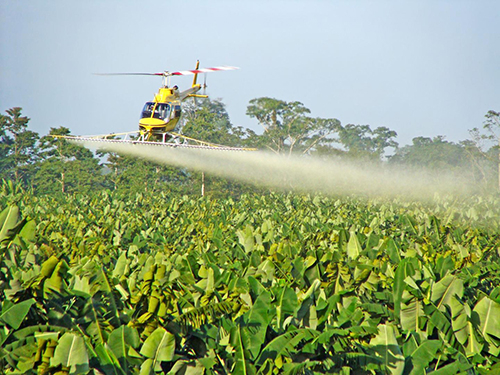![Aerial spraying of fungicides on a banana plantation. A fresh, genome-level understanding of the fungal pathogens that afflict banana plants promises to inform the development of more effective and, hopefully, less environmentally unfriendly crop protection products. [Gert Kema]](https://genengnews.com/wp-content/uploads/2018/08/Aug12_2016_GertKema_BananaPlantationBeingSprayed1852417154-1.jpg)
Aerial spraying of fungicides on a banana plantation. A fresh, genome-level understanding of the fungal pathogens that afflict banana plants promises to inform the development of more effective and, hopefully, less environmentally unfriendly crop protection products. [Gert Kema]
Bananas: so cheap, so plentiful…so vulnerable. They are harvested from plantations reliant on clones of one banana variety, the Cavendish. And the Cavendish is highly susceptible to the fungus Pseudocercospora fijiensis, which causes black sigatoka, or black leaf disease. Black sigatoka, along with a couple of closely related banana diseases, is so devastating it could bring back an old song: Yes! We Have No Bananas.
Legend has it the song was inspired by shortages another banana variety, the Gros Michel. Like the Cavendish, the Gros Michel was genetically uniform and vulnerable to blight. Ultimately it was taken out of cultivation, even though it was widely considered tastier than the Cavendish.
Could the Cavendish avoid the fate of the Gros Michel? Maybe, with the help of gene-sequencing technology, which has been used to unravel the DNA of P. fijiensis. Gene sequencing has also been used to discover how P. fijiensis and two closely related pathogens, P. musae and P. eumusae, have evolved into a lethal threat to the world’s bananas. P. musae causes yellow sigatoka disease, and P. eumusae causes eumasae leaf spot disease. Of the three pathogens, P. fijiensis poses the greatest constraint to banana production worldwide.
By studying the genomes of these pathogenic fungi, scientists hope to find ways to ensure the sustainable production of the banana, the world’s leading fruit crop. At present, the banana ranks fourth as a global staple food, with 140 million tons of bananas produced annually in subtropical and tropical regions. The banana industry could, however, be wiped out in just 5–10 years by fast-advancing fungal diseases. Already, the Sigatoka disease complex can reduce banana yields by 50–70%, if not controlled.
Genomic details of the pathogens threatening the banana appeared August 11 in the journal PLOS Genetics, in an article entitled, “Combating a Global Threat to a Clonal Crop: Banana Black Sigatoka Pathogen Pseudocercospora fijiensis (Synonym Mycosphaerella fijiensis) Genomes Reveal Clues for Disease Control.” The article, which was contributed by scientists based at the University of California (UC) Davis, and Wageningen University, suggested genomic insights could suggest ways to improve host resistance. Such insights could also inform sophisticated management of fungicide resistance in the pathogen.
“In the P. fijiensis genome sequence, we identified an effector that induced an HR [hypersensitive response]-like necrosis on a resistant banana accession but not on a susceptible cultivar,” wrote the article’s authors. “If validated, this assay may be useful for identifying resistance in banana breeding programs.”
The authors also reported that the genomic sequence was used to develop highly polymorphic molecular markers for analyzing P. fijiensis field populations and to identify a strong enrichment (nearly 100%) for fungicide resistance markers in fungicide-treated banana plantations compared to untreated wild-type populations. “This rapid evolution of fungicide resistance poses an immediate threat to sustainable banana production,” the authors noted. They added, however, that the P. fijiensis genome could aid in developing fungicide treatment schedules to combat the black sigatoka pathogen and in improving the efficiency of banana breeding programs.
Black sigatoka is airborne and affects the leaves of banana plants in small- and large-scale plantations, and without chemical control it results in huge yield losses. The disease also reduces the quality of the fruit, causing premature ripening.
“Black sigatoka has a huge social, ecological, and economic impact worldwide,” explained Gert Kema, professor in tropical phytopathology at Wageningen University. “Thanks to the sequencing of the DNA of the Pseudocercospora fungus, we are now gaining a greater insight into the interaction between the fungus and the banana plant. This provides us with leads for increasing the sustainability of banana cultivation, making it better for the environment, the local population, and the economy. For example, the insights offer us opportunities to develop a banana plant that is suitable for production and export, and which is also resistant against black sigatoka.”
This fresh understanding of the DNA of the black sigatoka fungus is also providing new information that is useful in the development of more effective and, hopefully, less environmentally unfriendly crop protection products. This could reduce the amount of fungicide spraying, which, in turn, would improve the quality of life of the people working in the plantations and those who live in the immediate surroundings.
“We have discovered that the two more destructive pathogens share a pattern of parallel changes in their core metabolic pathways that enables them to exploit more efficiently the nutrient resources available in banana,” added UC Davis molecular plant pathologist Ioannis Stergiopoulos. “Now, for the first time, we understand the genomic basis of the evolution of virulence in these fungal diseases, thus giving us an opportunity for intervention.”







